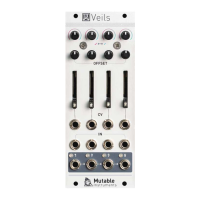
Do you have a question about the Mutable Instruments Veils and is the answer not in the manual?
| Brand | Mutable Instruments |
|---|---|
| Model | Veils |
| Category | Synthesizer |
| Language | English |
Description of VCAs as building blocks and how Veils provides four VCAs with adjustable response and daisy-chained outputs.
Details Veils' power supply needs (-12V/+12V) and LED brightness dependency on current consumption.
Explains the continuously variable response curve (A) and the positive offset control (B) for CV signals.
Details the Gain CV amount control (C) and the normalized Gain CV input (2) for modulation.
Describes the DC-coupled signal input (3) and the daisy-chained signal output (5) with sum functionality.
Explains the Gain indicator LED (1) and the Output indicator LED (4) and their function.
